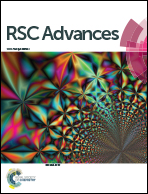Optical band gap tuning by laser induced Bi diffusion into As2Se3 film probed by spectroscopic techniques
Abstract
Amorphous chalcogenide semiconducting materials are very sensitive to electromagnetic radiation and are useful for infrared optics and play a pivotal role in modern technology. In the present article, As2Se3 and bilayer Bi/As2Se3 thin films were prepared by thermal evaporation method. The 532 nm laser induced diffusion of active Bi top layer into barrier As2Se3 film was probed through spectroscopic techniques. An X-ray diffraction study reveals no structural change due to laser irradiation while the optical parameters are affected by both Bi addition and laser irradiation which brings a change in the transmittivity and absorption coefficient. The indirect optical band gap is found to be decreased by 0.11 eV due to Bi addition to As2Se3 which is explained on the basis of density of defect states with an increase in disorder. The laser irradiated Bi diffusion increases the optical band gap by 0.05 eV (photobleaching) with a decrease in disorder. The Tauc parameter and Urbach energy which measures the degree of disorder change with Bi doping and irradiation. The refractive index is modified by the illumination process which is useful for optical applications. The optical property change is well supported by X-ray photoelectron core level spectra and Raman spectra.



 Please wait while we load your content...
Please wait while we load your content...